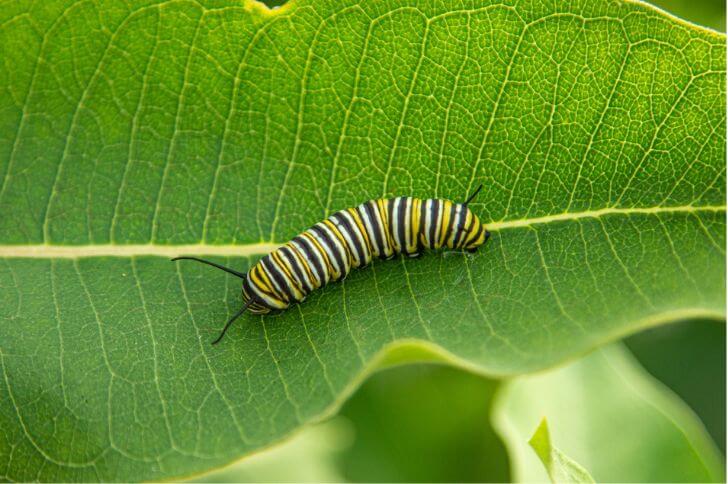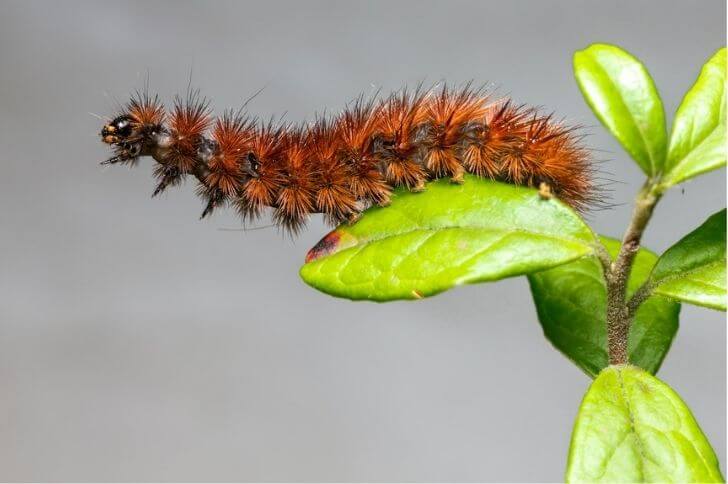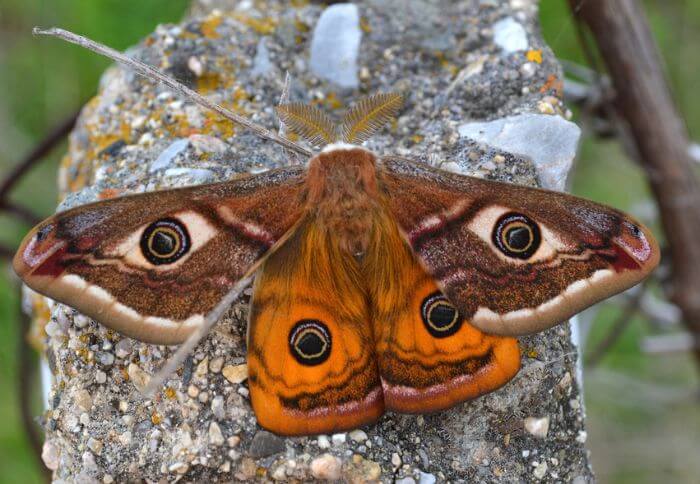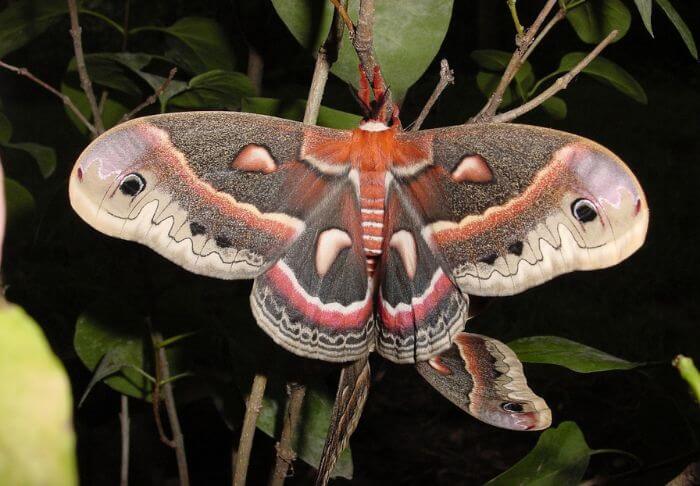10 Large Moths in Michigan (with Pics)
Nestled amidst the lush woodlands and shimmering lakes of Michigan, a silent and enchanting spectacle awaits as twilight descends – the breathtaking sight of large moths taking flight.
With their impressive wingspans and often vivid colors, these magnificent creatures have long captivated the imagination of naturalists and casual observers alike.
From the elusive Polyphemus moth to the majestic Luna moth, Michigan is home to a diverse array of large moth species that add a touch of magic to its nocturnal landscapes.
Large Moths in Michigan
1. Giant Silk Moths
In the quiet forests of Michigan, a magical spectacle takes place when giant silk moths emerge from their cocoons.
These magnificent creatures, such as the Cecropia moth and Luna moth, are adorned with stunning patterns and vibrant colors that seem almost otherworldly amidst the lush greenery. The sight of their large wings flitting gracefully through the trees is a testament to nature’s artistry and resilience.
What makes these giant silk moths especially intriguing is their short but impactful lifespan. As adults, they dedicate their energy to reproduction, often living only for about a week.
During this time, they release pheromones to attract mates before laying eggs on suitable host plants. Witnessing this fleeting yet vital cycle can inspire a deeper appreciation for the interconnectedness of ecosystems and the beauty of impermanence in nature.
As we glimpse these wondrous creatures in Michigan’s woodlands, it serves as a stark reminder of the delicate balance necessary for their survival within our rapidly changing environment.
Embracing opportunities to encounter these giant silk moths offers us not only a chance to marvel at their splendor but also an invitation to reflect on our role in protecting and preserving natural wonders for generations to come.
2. Luna Moth
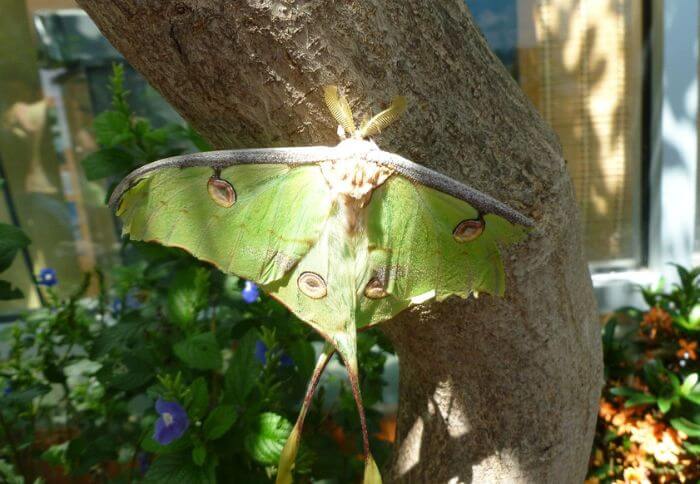
The Luna moth, an enchanting creature with its striking lime green wings and long sweeping tails, is a sight to behold in the forests of Michigan.
What sets this magnificent moth apart is its short lifespan as an adult, typically living for only about one week.
This fleeting existence adds to the allure of catching a glimpse of this ethereal being amidst the foliage.
The Luna moth’s intricate relationship with nature also sets it apart from other large moths in Michigan.
As a member of the Saturniidae family, it relies on certain tree species such as birch and sweet gum for larval food plants.
Understanding these ecological connections deepens our appreciation for the delicate balance of our natural world. Seeing a Luna moth isn’t just observing a beautiful insect; it’s witnessing nature’s intricate web at work in our own backyard.
3. Polyphemus Moth
The Polyphemus moth (Antheraea polyphemus) is a striking large moth that can be found in the state of Michigan.
With a wingspan reaching up to 6 inches, it is one of the most impressive species of moths in the region.
What makes this moth particularly fascinating is its unique eye-like markings on its hindwings, which serve as a defense mechanism against predators.
When threatened, the Polyphemus moth can flash these eyespots, startling would-be attackers and allowing the moth to escape.
Another remarkable feature of the Polyphemus moth is its short but intense lifespan.
After spending several weeks as a cocoon during winter, adult moths emerge in early summer and have only about a week to mate and lay eggs before succumbing to natural causes.
This brief window of existence adds an element of urgency to their life cycle, making each encounter with these majestic creatures all the more special for nature enthusiasts in Michigan.
4. Imperial Moth
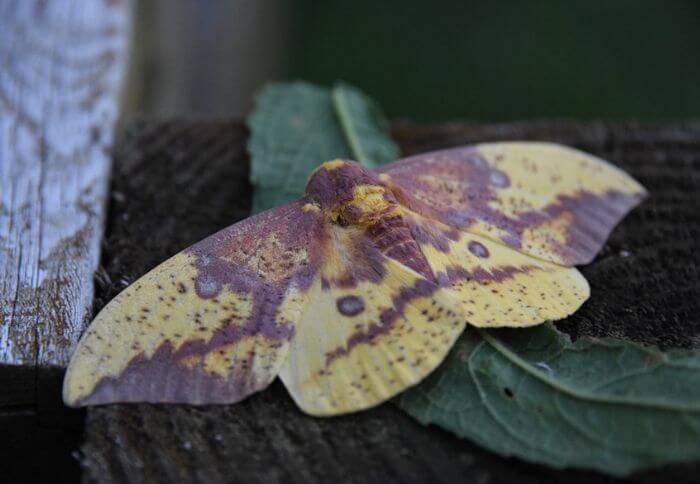
The Imperial moth, a majestic creature of the night, can be spotted in Michigan’s woodlands during its brief adult stage.
With its wingspan reaching up to 7 inches, this imposing moth is a sight to behold as it gracefully flutters through the summer air.
Its striking coloration, featuring shades of tan, brown, and purple, make it a standout among other large moths in the region.
Despite its grandeur, the Imperial moth is elusive and tends to keep to itself, adding an air of mystery to its presence in Michigan’s natural landscape.
This captivating species undergoes a remarkable transformation from caterpillar to moth, spending most of its life cycle hidden from plain view.
The caterpillars feed on various tree leaves including oak and hickory before cocooning themselves for their dramatic metamorphosis.
Once emerged as adults, Imperial moths have only a few weeks to mate and fulfill their purpose before succumbing to their short-lived existence.
Their fleeting appearance serves as a reminder of nature’s ephemeral beauty and the intricate interconnectedness within Michigan’s ecosystems.
5. Cecropia Moth
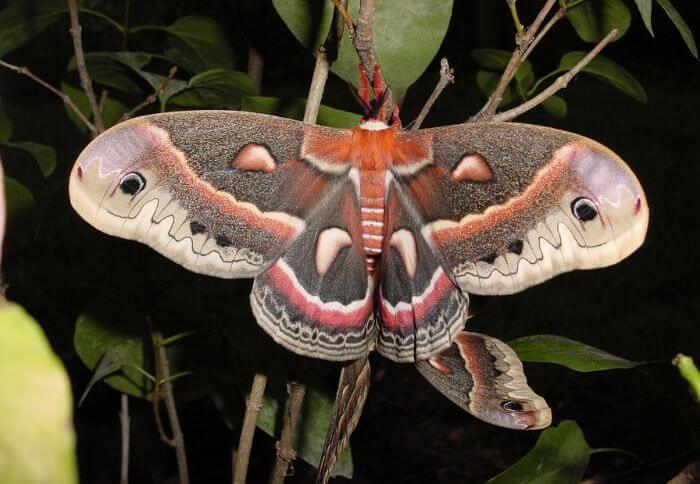
The Cecropia moth, also known as Hyalophora cecropia, is a majestic creature that captures the imagination of anyone lucky enough to encounter it in Michigan.
With a wingspan of up to 6 inches, this stunning insect is the largest native moth in North America and is truly a sight to behold.
Its reddish-brown wings are adorned with charming white and beige markings, making it a striking presence against the green foliage of Michigan’s forests.
What truly sets the Cecropia moth apart is its unique life cycle. After emerging from its cocoon, the adult moth lives for only about two weeks—just enough time to mate and lay eggs before perishing.
This fleeting existence adds an element of preciousness to every sighting of these ethereal creatures in Michigan’s woods.
Despite their short lifespan, Cecropia moths play an important role in ecosystems as pollinators, contributing to the health and diversity of plant life across the region.
Encountering a Cecropia moth in Michigan is not just an opportunity to witness natural beauty, but also a chance to marvel at nature’s intricate processes and interconnectedness.
These enchanting giants serve as gentle reminders of the richness and fragility of our local environment, inspiring us to appreciate and protect our natural world for generations to come.
6. White-lined Sphinx
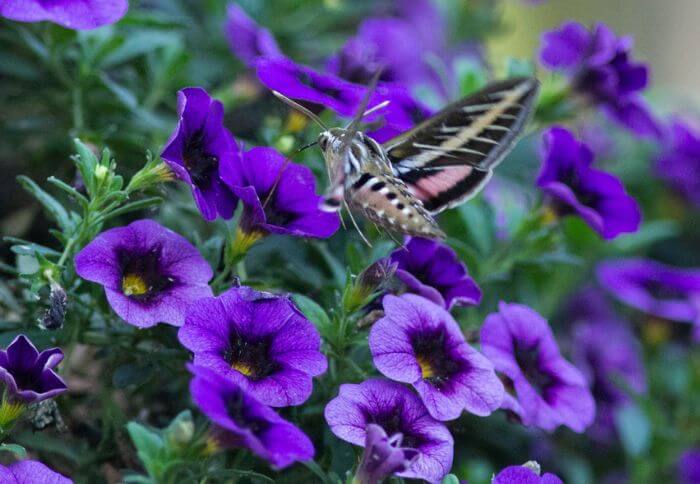
The White-lined sphinx, also known as the hummingbird moth, is a stunning and enigmatic creature that graces the skies of Michigan with its ethereal presence.
With a wingspan of up to 4 inches, this majestic moth captivates onlookers with its graceful flight and striking appearance.
Its white-lined wings and olive-green body create a mesmerizing spectacle against the backdrop of twilight, as it flits from flower to flower in search of nectar.
One fascinating aspect of the White-lined sphinx is its ability to hover in mid-air while feeding, resembling a tiny hummingbird.
This unique behavior sets it apart from other moths and creates a sense of wonder for those fortunate enough to witness it in action.
Furthermore, the symbiotic relationship between these moths and certain flowering plants highlights their crucial role in pollination, contributing to the rich biodiversity that thrives in Michigan’s natural landscapes.
The White-lined sphinx’s presence serves as an important reminder of the delicate balance within ecosystems, showcasing the interconnectedness of all living beings.
Its resilience and beauty remind us to appreciate nature’s intricate wonders and foster a deeper respect for our environment.
7. Pandora Sphinx Moth
The Pandora Sphinx Moth, also known as Eumorpha pandorus, is a magnificent creature that graces the skies of Michigan with its ethereal presence.
With a wingspan that can reach up to 4-5 inches, this large moth captivates onlookers with its intricate patterns and shades of green and pink.
The sight of a Pandora Sphinx Moth in flight is truly mesmerizing, as it gracefully glides through the air like a magical creature from another world.
This enchanting moth species goes through a remarkable transformation from caterpillar to adult moth. Its caterpillar stage is equally intriguing, sporting vibrant colors and intimidating eye-like markings to deter potential predators.
Despite their seemingly otherworldly appearance, Pandora Sphinx Moths play an essential role in their ecosystem as pollinators for various flowering plants.
Their presence reminds us of the delicate balance and interconnectedness of nature’s wonders right here in Michigan.
8. Achemon Sphinx
The Achemon sphinx, with its distinctive olive-green and pinkish hues and impressive wingspan of up to 5 inches, is a captivating sight in the forests of Michigan.
Its large size and intricate patterns make it a mesmerizing addition to the local wildlife.
This species has evolved to be an expert at camouflage, blending seamlessly into the surrounding foliage during the day while providing a breathtaking display when in flight at dusk.
One of the most intriguing aspects of the Achemon sphinx is its unique life cycle. As caterpillars, they feed on grape leaves and are known for their role as beneficial pollinators as adults.
By delving into this lesser-known aspect of their behavior, we gain a deeper appreciation for their ecological significance within Michigan’s ecosystem.
Observing these majestic creatures in their natural habitat can be an awe-inspiring experience, offering a reminder of the beauty and diversity that thrives within our local environment.
Related Read: Check brown and pink moths
9. Elm Sphinx
The Elm sphinx, a strikingly beautiful moth found in Michigan, is known for its distinct olive-green wings and intricately patterned body.
Despite its large size and enchanting appearance, this species remains relatively elusive due to its nocturnal habits.
The Elm sphinx plays an important role in Michigan’s ecosystem as a pollinator, contributing to the diversity of plant life in the region.
One fascinating aspect of the Elm sphinx is its unique feeding behavior as a caterpillar. This species has been observed feasting on the leaves of elm trees, hence its name.
However, it’s not limited to exclusively feeding on elm trees and can also be found on other vegetation such as birch and willow. This flexible diet allows the Elm sphinx to adapt to various habitats within Michigan’s diverse landscapes.
10. Giant Leopard Moth
The Giant Leopard Moth, with its striking black and white spotted wings, is a captivating sight in the forests of Michigan.
This large moth is known for its impressive size and bold markings, standing out against the greenery as it flutters gracefully through the trees.
Despite its impressive appearance, the Giant Leopard Moth is often elusive, making sightings an exciting and rare event for nature enthusiasts in Michigan.
One fascinating aspect of the Giant Leopard Moth is its life cycle, which begins with a stunning display of metamorphosis.
The caterpillar stage showcases vibrant colors and intricate patterns, making it a sight to behold in itself.
As it matures into a moth, the transformation from caterpillar to adult is a testament to nature’s beauty and complexity. Furthermore, these moths play an essential role in pollination and ecosystem balance within Michigan’s diverse landscape.
11. Carolina Sphinx
The Carolina Sphinx, also known as the Tobacco Hornworm, is a strikingly beautiful large moth species found in Michigan.
With its impressive wingspan and intricate patterns, these moths are a fascinating sight to behold.
Despite their delicate appearance, Carolina Sphinx moths play an important role in local ecosystems as pollinators and contributors to the natural balance of insect populations.
One of the most intriguing aspects of the Carolina Sphinx is its unique life cycle. Starting as larvae feeding on tobacco plants and other solanaceous species, they undergo a remarkable transformation into full-grown moths with powerful flight capabilities.
Observing this metamorphosis firsthand can provide a deep appreciation for the wonders of nature and the diverse forms it takes.
By shedding light on these lesser-known creatures, we gain a greater understanding of the complexity and beauty that exists within our own backyard.
Final Thoughts:
Michigan is home to a diverse range of large moths, including the Luna moth, Polyphemus moth, and Cecropia moth.
These fascinating creatures play an important role in the ecosystem and are a valuable part of the state’s biodiversity.
As more people become interested in the natural world around them, it is essential to appreciate and protect these magnificent insects.
By learning about and conserving the habitats of these moths, we can ensure that future generations will have the opportunity to marvel at their beauty. Let’s work together to preserve the rich variety of large moths in Michigan for years to come.
source:
Passionate animal photographer with an unwavering love for capturing the essence and beauty of our furry friends.
With over five years of experience in the field, I have developed a unique ability to connect with animals on a deeper level, allowing me to create stunning and captivating images that truly reflect their personality.
Let’s collaborate to capture unforgettable moments that celebrate the unique bond between humans and animals!


